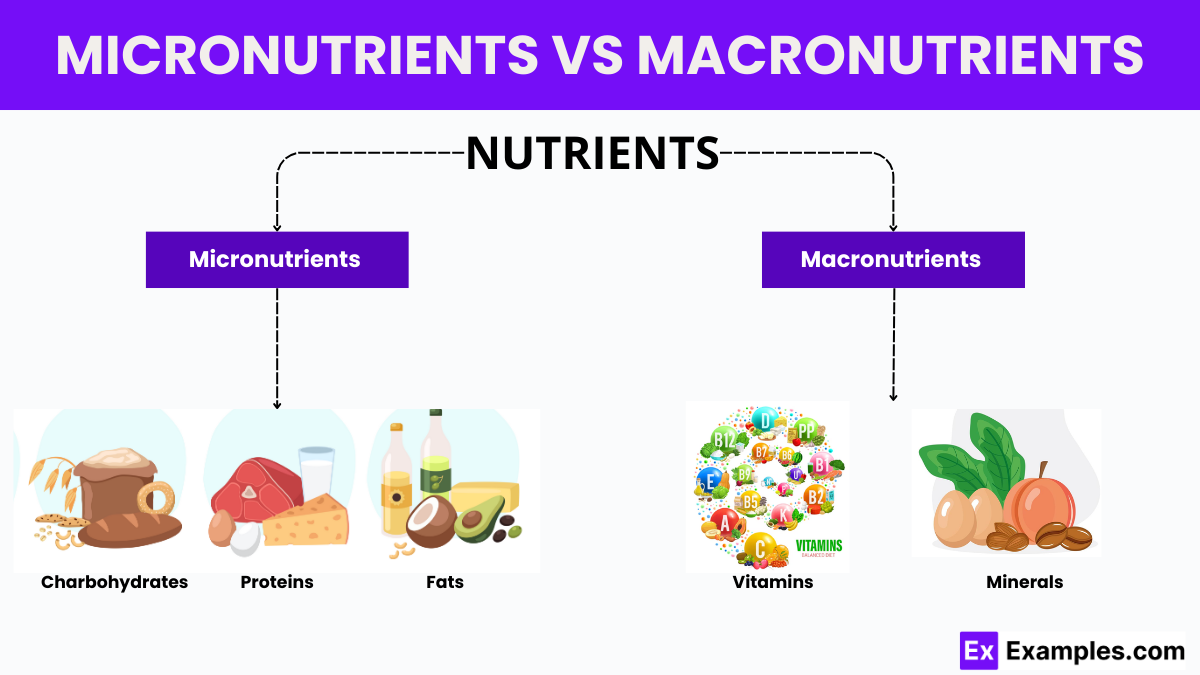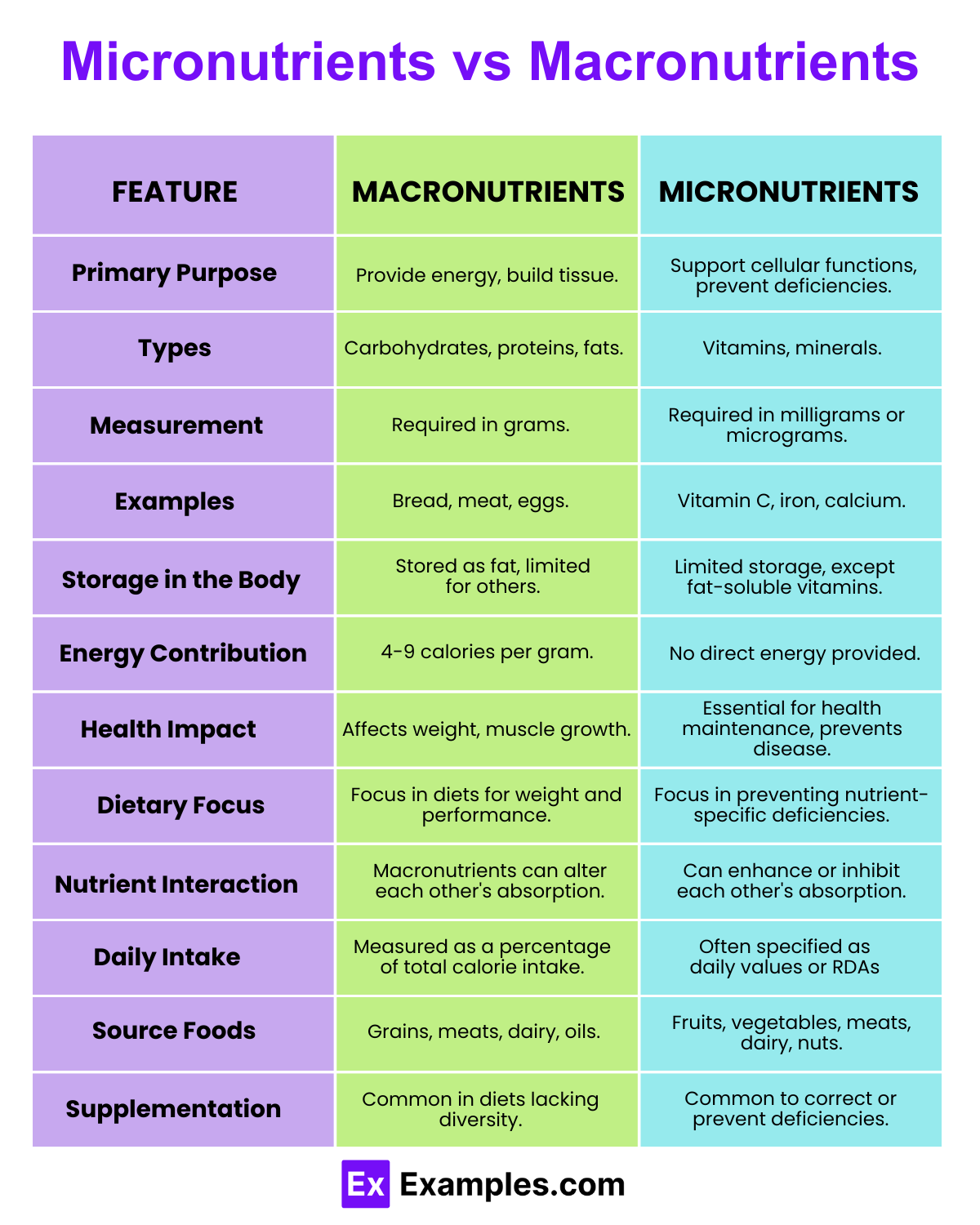Which of the following is considered a macronutrient?
Vitamin C
Iron
Carbohydrates
Zinc


Micronutrients and macronutrients are essential components of our diet, each serving unique functions. Macronutrients, including fats, proteins, and carbohydrates, are required in larger amounts to provide energy and support overall health. They are found in a variety of foods like meats, grains, and dairy, which also supply crucial micronutrients such as vitamins and minerals. Micronutrients, although needed in smaller quantities, are vital for proper body functions and are present in foods across all macronutrient groups. Understanding the balance of these nutrients is key, though the ideal ratio can vary from person to person. Rather than striving for a ‘perfect’ balance, focusing on a varied diet as recommended by dietary guidelines ensures a healthy intake of both macro and micronutrients.
Macronutrients are the primary components of our diet, needed in large quantities to maintain the body’s structure and functions. These include proteins, fats, and carbohydrates, each providing energy measured in calories. Proteins build and repair tissues, fats supply essential fatty acids and facilitate the absorption of vitamins, while carbohydrates serve as the main energy source.
Carbohydrates form the cornerstone of energy supply, breaking down into glucose which fuels bodily functions and enhances digestion and satiety. Common sources include:
Each gram of carbohydrate provides 4 calories.
Fats are crucial for the absorption of fat-soluble vitamins such as Vitamins A, D, E, and K. They break down into fatty acids and glycerol, contributing to brain health and energy reserves. Rich sources are:
Fats offer a higher calorie content, providing 9 calories per gram.
Proteins are essential for the growth and repair of muscle, tissues, and organs and play a vital role in hormone regulation. High-protein foods include:
Protein provides 4 calories per gram.
The Dietary Guidelines for Americans suggest obtaining 45-65% of your calories from carbohydrates, 20-35% from fats, and 10-35% from proteins. Adjusting these macronutrient ratios can help manage weight, build muscle, and regulate blood sugar, among other goals.
Micronutrients, unlike macronutrients, are required in smaller amounts but are vital for overall health and body functions. They include vitamins and minerals that support processes like enzyme function, hormone production, and brain operation, though they do not provide energy.
Vitamins:
Minerals:

| Aspect | Macronutrients | Micronutrients |
|---|---|---|
| Definition | Nutrients required in larger amounts that provide energy and are essential for structure and functioning of the body. | Nutrients needed in smaller quantities that support specific bodily functions and prevent nutrient deficiencies. |
| Types | Carbohydrates, proteins, fats. | Vitamins (e.g., vitamins A, C, D, E, and K), minerals (e.g., iron, calcium, zinc). |
| Primary Functions | Provide energy, support growth, development, and repair of tissues, and regulate body processes. | Ensure proper cellular function, support immune system, contribute to growth and development, and help prevent diseases. |
| Energy Contribution | Carbohydrates and proteins provide about 4 calories per gram, while fats provide about 9 calories per gram. | Do not provide energy directly, but facilitate metabolic processes that generate energy. |
| Sources | Meat, dairy products, grains, legumes, nuts. | Wide variety, including fruits, vegetables, nuts, seeds, meat, and dairy products. |
| Daily Requirements | Generally measured in grams. | Generally measured in milligrams or micrograms. |
| Storage in Body | Excess macronutrients can be stored as body fat. Proteins and carbohydrates have limited storage capacities. | Most micronutrients cannot be stored in large amounts, except fat-soluble vitamins like vitamins A, D, E, and K. |
| Health Impacts | Imbalances can lead to weight gain or malnutrition diseases like diabetes or heart disease. | Deficiencies can cause diseases like scurvy (vitamin C deficiency) or anemia (iron deficiency). |
| Balancing Importance | Essential for managing weight, energy levels, and overall health. | Critical for preventing diseases, aiding in the function of enzymes, and supporting overall health. |
| Interaction | Macronutrients often work together to optimize energy use and muscle repair (e.g., carbohydrates and proteins). | Micronutrients can enhance or inhibit the absorption of other nutrients (e.g., vitamin C enhances iron absorption). |
| Dietary Focus | Often the focus of weight management and athletic diets (e.g., counting macros). | Focused on in precision nutrition and to address specific health concerns like bone health or immunity. |
When discussing nutrition, it’s crucial to understand the roles and requirements of both micronutrients and macronutrients. These nutrients are fundamental for maintaining health, but they serve different purposes and are needed in varying quantities.
Essential for Health: Both micronutrients and macronutrients are essential for maintaining good health. They play critical roles in bodily functions, from building and repairing tissues to supporting metabolic processes.
Presence in Foods: You can find both types of nutrients in a wide variety of foods. A balanced diet often includes a mix of both macro- and micronutrients, providing the body with a comprehensive range of nutrients needed for optimal health.
Involvement in Metabolic Pathways: Both micronutrients and macronutrients are integral to metabolic pathways. Macronutrients provide the raw energy to fuel metabolic processes, while micronutrients often act as co-factors or co-enzymes necessary for metabolic reactions.
Amount Required: The most apparent difference lies in the quantities required by the body. Macronutrients, including proteins, fats, and carbohydrates, are needed in large amounts, as they are the primary sources of energy. Micronutrients, such as vitamins and minerals, are required in much smaller quantities because they are used to catalyze physiological functions rather than as fuel.
Energy Provision: Macronutrients are the body’s main energy source. Carbohydrates and fats provide immediate and stored energy, respectively, while proteins primarily serve to build and repair tissues but can be used for energy if necessary. On the other hand, micronutrients do not provide energy themselves but are crucial in helping the body utilize the energy produced from macronutrients.
Macronutrients provide energy and are needed in large amounts, while micronutrients support bodily functions and are required in smaller quantities.
The three main micronutrients are vitamins, minerals, and trace elements.
Examples of micronutrients include vitamin C, iron, calcium, zinc, and vitamin D.
Macronutrients include fats, proteins, and carbohydrates for energy and growth, whereas micronutrients like vitamins and minerals support health at a cellular level.
Both micronutrients and macronutrients are essential; balance is key, as each plays critical roles in health and well-being.
Text prompt
Add Tone
10 Examples of Public speaking
20 Examples of Gas lighting
Which of the following is considered a macronutrient?
Vitamin C
Iron
Carbohydrates
Zinc
Which of the following is an example of a micronutrient?
Protein
Fat
Calcium
Carbohydrate
What is the primary function of macronutrients in the body?
To regulate metabolic processes
To provide energy and build tissues
To enhance enzyme activity
To maintain fluid balance
Which of the following nutrients is required in very small amounts and is essential for enzyme function?
Carbohydrates
Vitamins
Proteins
Fats
Which of the following is NOT a macronutrient?
Fats
Carbohydrates
Fiber
Vitamins
What distinguishes micronutrients from macronutrients?
Micronutrients are required in larger quantities
Micronutrients are involved in energy production
Micronutrients are required in smaller quantities
Micronutrients are the primary building blocks of the body
Which of the following is an example of a macronutrient involved in muscle repair?
Vitamin D
Iron
Protein
Magnesium
What role do micronutrients play in maintaining health?
Provide primary energy sources
Build and repair body tissues
Support immune function and cellular processes
Facilitate digestion of macronutrients
Which of the following nutrients is most likely to be deficient in a diet lacking in fruits and vegetables?
Protein
Carbohydrates
Vitamin C
Fats
Which macronutrient provides the most energy per gram?
Carbohydrates
Protein
Fat
Fiber
Before you leave, take our quick quiz to enhance your learning!

